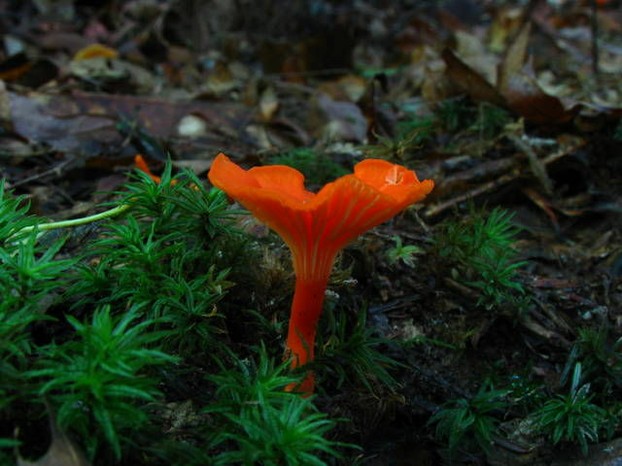For canning:
- Cut red chanterelles into big chunks and steam for 20 minutes.
- Then deposit steamed pieces into small canning jar(s). Cover pieces either with leftover steaming liquid or water or any favored canning liquid.
- Sterilize for 40 minutes. If using a pressure cooker, set pressure at 10 pounds.
For drying:
Most chanterelles, including reds, do not respond well to preservation through dehydration, which emphasizes a disagreeably tough, chewy texture even after rehydrating.
- Nevertheless, stews agree with dried reds by tenderizing them during the long, slow cooking process.
- Drying may be done either with a dehydrator or on drying trays.
For manual drying, thinly slice after cleaning and nestle slices on paper towels atop screens or trays in a sunny, ventilated location for one to two days.
- Turn the slices over a few times so both sides are exposed to air currents.
- Brittleness and easy crumbling signal that dehydration is complete.
To rehydrate, barely cover with warm water. Allow to sit for at least 15 minutes.
Reserve this soaking liquid afterwards as flavors from the dried reds are released into it. This flavored liquid may be added to gravy, rice, stews, etc.
For freezing:
Red chanterelles emerge unscathed from proper freezing. It is important firstly to dry sauté reds in a pan over medium heat. Heat causes them to release stored liquid. This moisture then evaporates.
- With only a little of the moisture remaining, add at least enough butter to cover the bottom of the pan. Generous amounts of butter are beneficial: adding butter is important to release and preserve the flavorful components, which are fat soluble.
- Seasoning may be added here. Reds work their magic on any and all seasonings. Favorites include parsley, thyme, and tarragon.
- Sauté for about 5 minutes.
Sealed in freezer bags, reds rest nonchalantly in freezers. Removed for thawing, even a year or longer afterwards, reds awaken with gusto with their color, flavor, and texture all virtually intact and ready to please.
For pickling:
Red chanterelles pickle extraordinarily well, especially in white wine.
The addition of oil -- of which my favorites are olive and sunflower -- at the beginning and at the end captures the above-mentioned, fat-soluble virtues of red chanterelles.
1. Deposit red chanterelles in a pot and add a bottle of white wine (my preference is for Riesling or Sauvignon Blanc), along with several teaspoons of oil.
- Cook for about 20 minutes on medium heat.
- Occasionally check that the pot does not boil dry, which usually does not happen due to the extra liquid released by the red chanterelles.
2. Squeeze one lemon -- or splash 2 to 3 tablespoons of lemon juice -- over the mushrooms after cooking and then toss several times.
3. Set a sufficiently-sized colander into another pot and empty the mushrooms and their cooking liquid into it.
4. After the liquid has mostly drained from the colander, pack red chanterelles into sterile jars, leaving at least one inch of headroom, that is, clearance from the jar lip.
- Note: Sometimes I separate reds from the cooking liquid with a slotted spoon to keep the liquid in the cooking pot, which further binds flavors as the pot releases its built-up heat.
- In each jar, cover mushrooms with cooking liquid. Top with a few drops of oil.
- Tightly apply lids.
- Shake to dislodge any air bubbles trapped among the reds.
Store in the refrigerator, where these pickled treasures await their next command performance, lasting easily for one or two years!

















 Are Hawaiian Huakai Po Nightmarchers Avenging Halloween Thursday?on 10/02/2024
Are Hawaiian Huakai Po Nightmarchers Avenging Halloween Thursday?on 10/02/2024
 Mailing Addresses for 2023 Form 4868 Extending 1040 and 1040SR April 15, 2024, Due Dateon 04/15/2024
Mailing Addresses for 2023 Form 4868 Extending 1040 and 1040SR April 15, 2024, Due Dateon 04/15/2024
 Mailing Addresses for 2023 Forms 1040 and 1040SR Filed in 2024on 04/15/2024
Mailing Addresses for 2023 Forms 1040 and 1040SR Filed in 2024on 04/15/2024
 Mailing Addresses for 2022 Form 4868 Extending 1040 and 1040SR April 18, 2023, Due Dateon 04/13/2023
Mailing Addresses for 2022 Form 4868 Extending 1040 and 1040SR April 18, 2023, Due Dateon 04/13/2023



Comments